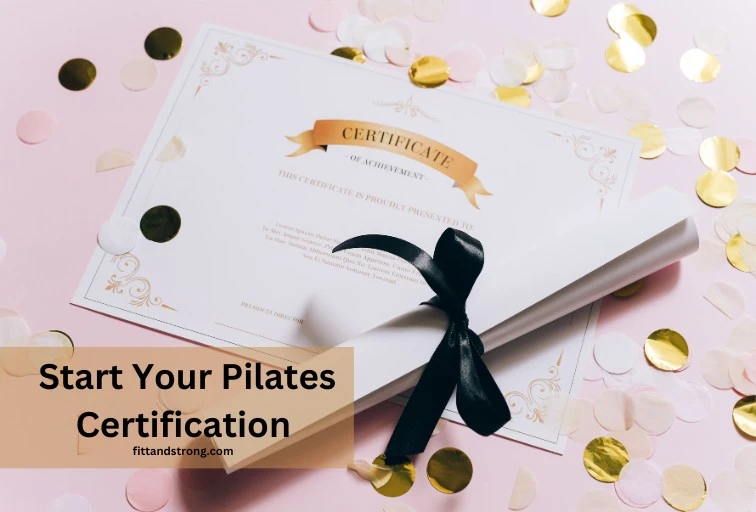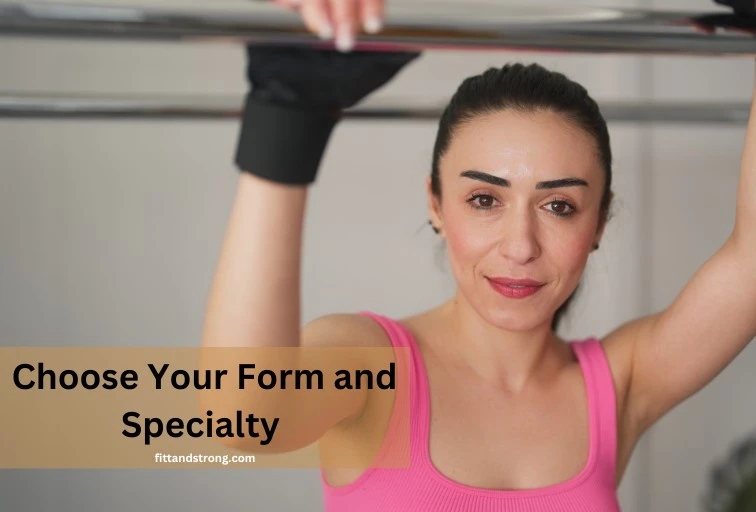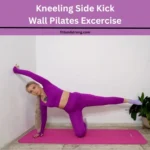Becoming a Pilates instructor requires more than just a passion for the art; it demands a disciplined approach to practice and knowledge.
I’ve spent 12 years mastering how to teach clients safely and effectively, and I’m here to share that insight with you. It’s not merely about instructing; it’s about Transforming lives through Pilates.
If you’re wondering how to become a Pilates instructor, know that it starts with a passion for the art and a commitment to practice.
Follow These Guidelines to Become a Pilates Instructor:
- Gain experience with Pilates exercises to start your path.
- Enroll in a comprehensive training program for in-depth learning.
- Begin teaching, observing, and continue your personal practice.
- Prepare for and take the Certification Program Exam to qualify.
Furthermore, This guide will outline in detail how to become a successful Pilates teacher. We’ve covered all questions, big and small, offering all information related to being a Pilates instructor in one place. Let’s jump right in.
8 Steps to Become a Certified Pilates Instructor
Luckily, there are clear steps to take to become a certified Pilates instructor. Once you’ve completed a comprehensive certification program, you’ll be on your way to success.
1. Take a Pilates Class
Sparking your interest in becoming a Pilates instructor starts by hitting the mat. Immerse yourself in the lifestyle and learn about its long history and how it evolved. This is the first step in understanding the depth of Pilates.
To truly feel the essence of Pilates, locate your local Pilates studio and take a variety of classes at different studios. Experimenting with techniques you’re passionate about will help you find your niche within the Pilates world.
If you’re interested in joining a specific community, I’ve written a post about the Club Pilates Membership Prices. Please check it out to understand the commitment and benefits that come with joining a professional Pilates network.
2. Choosing Your Pilates Path: Classical vs. Contemporary
To begin your Pilates instructor training, it’s crucial to choose which route will narrow down your specialization. The common routes are classical and contemporary Pilates, each offering unique perspectives on this fitness discipline. Your choice will shape your teaching style and expertise.
Classical Pilates sticks closely to the techniques initially introduced by Joseph Pilates, the founder of this physical fitness system. This path emphasizes the purity and integrity of the original exercises and philosophies, appealing to purists and those who value the historical roots of Pilates.
Contemporary Pilates, conversely, is fundamentally based on Pilates’ work but heavily influenced by physical therapy, among other changes as determined by individual instructors.
This modern approach allows for innovation and adaptation, catering to those who wish to incorporate current fitness trends and rehabilitative techniques into their Pilates practice.
3. Start Your Pilates Certification Program

To begin your Pilates certification process, research thoroughly. Use Google to find a training course plan that fits your lifestyle, work, life, and travel flexibility.
After selecting the right program, you’ll facilitate study hours involving classroom training, studio practice, practice teaching, and observation hours. These components are essential, preparing you for the comprehensive Pilates teaching experience.
It’s a journey filled with FUN, as you dive into hundreds of hours of Pilates, enhancing both your skills and understanding of this dynamic discipline.
Completing these hours and your anatomy training are prerequisites before you can book your test with an Instructor Trainer (IT). Upon full certification completion, consider further certification by entities like the Pilates Method Alliance (PMA) or the National Pilates Certification Program (NPCP).
These additional certifications can elevate your credentials and open more doors within the Pilates community.
4. Choose Your Form and Specialty
When you begin your Pilates instructorship, exploring different specializations and forms becomes crucial. Choosing a specialty gives direction to your practice and helps build your brand in the competitive market. It determines the type of clients you’ll take on and the areas where you’ll likely focus your own training.
There are numerous ways, styles, and levels to teach like Mat Pilates and Reformer, each with its own set of specialties. Deciding whether to focus on all, some, or just one can significantly impact your career path.
- Mat Pilates is great for beginners and offers flexibility in practice settings.
- Reformer Pilates requires specific equipment but provides a diverse range of exercises.
- Choosing between Chair, Cadillac, and Barrels allows for specialized client sessions and targeted outcomes.

Among the frequently encountered specialties in Pilates are:
- Pre- and post-natal Pilates for new and expecting mothers.
- Pilates for weight loss to aid in fitness goals.
- Pilates for athletes to enhance performance.
- Pilates for chronic pain management.
- Pilates for post-surgery or accident recovery.
- Pilates for arthritis and joint pain relief.
- Pilates for the aging population to maintain mobility.
- Pilates for dance enthusiasts.
- Pilates as fitness for a modern, edgy, up-beat workout.
When I started as a Pilates teacher, my practice took a contemporary/fitness Pilates direction, blending modern elements with traditional exercises. It’s crucial to figure out where your training program is leading you and start to practice teaching in your unique style.
Teaching Pilates to friends, family, and anyone willing to participate is important. You’ll need to log hours of teaching, potentially +500 hours or more across all modalities, to complete your full certification. This hands-on experience is invaluable in shaping your approach and expertise as an instructor.
5. Take Your Test
After you complete your Pilates training program, it’s finally time to take your certification exam. If you chose to pursue the contemporary approach, be ready for both a written and practical test, including postural analysis. The classical approach may require you to meet benchmarks and apprentice work.
A proper certification course can cost between $500 to $2000 per modality, and each exam component has an additional cost. Budgeting for these expenses is crucial as you prepare to demonstrate your skills and knowledge through these comprehensive evaluations.
Upon receiving your Pilates certification (congratulations!), you can relax and celebrate your achievement. However, to keep your certification updated, it’s important to continue improving and growing by enrolling in assigned continuing education Pilates courses throughout your teacher journey.
6. Find Liability Insurance
Securing professional liability insurance is a crucial step for any Pilates instructor. It’s essential in protecting yourself, your clients, and your business from unforeseen circumstances. The level of liability insurance needed depends on where you’re holding Pilates classes.
If you’re teaching Pilates at home, you’ll need a separate liability insurance. Meanwhile, teaching in a studio as a contractor requires liability insurance that carries with you wherever you go, ensuring coverage in various settings.
7. Start Teaching
Once you’ve completed your certification and secured your liability insurance, it’s time to start. Researching local Pilates studios that are hiring a certified instructor is a smart move when you’re first starting. This initial step can provide valuable experience and a supportive community to help you grow.
Working in a studio allows you to further your skills with the help of experienced instructors. As you become more confident in teaching on your own, you may even consider opening your own studio. It’s an exciting way to start teaching and share your passion for Pilates with others.
8. Never Stop Learning
Learning is the backbone of becoming a better teacher. Never stop seeking knowledge from teachers, clients, and the community. Each interaction enriches your Pilates practice. Life’s experiences deeply inform how we teach and connect. Keeping an open mind to learning enhances your skills.
Your Pilates practice is an important, ongoing journey. Embrace learning at every step. Let teachers, clients, and community experiences shape your teaching style. Improving your practice is a never-ending path that makes you a better teacher.
Pros and Cons of Being a Pilates Instructor
Let’s chat about what it’s like to be a Pilates teacher. Like any job, it’s got its ups and downs, but knowing what they are can help you decide if it’s the right fit for you.
Good Stuff (Pros) | Not-So-Good Stuff (Cons) |
|---|---|
Pick Your Own Hours – Work when you want, which is awesome for your schedule. | Money Ups and Downs – Sometimes you make lots, sometimes not so much, depending on your classes. |
Help People Feel Great – You get to help folks feel healthier and happier, which is super rewarding. | Costs to Get Started – Getting trained can be pricey, taking both money and time. |
Work Almost Anywhere – From gyms to studios, or even your own place, there’s a lot of choices on where to teach. | Tough on Your Body – Teaching a lot can be hard on your own health if you’re not careful. |
Always Learning – There’s always new stuff to learn in Pilates and health, keeping things interesting. | Building Your Tribe Takes Time – Finding loyal students doesn’t happen overnight. It’s a slow build. |
Make Friends – You’ll meet lots of people and make new friends, both with students and other teachers. | Lots of Competition – There are a ton of teachers out there, so you’ve gotta find a way to stand out. |
So, being a Pilates instructor is pretty awesome, but it’s not all smooth sailing. If you love helping people and are up for the challenge, it could be the perfect job for you. Just go into it with your eyes open, ready to work hard and reap the rewards!
9 Pilates Certifications Instructor courses in 2024
- ISSA Pilates Instructor Course
- Club Pilates Teacher Training program
- ACE Pilates Certification
- Pilates Certification Focused on Joseph Pilates’ Teachings
- Balanced Body Pilates Certification
- Stott Pilates Certification
- Power Pilates Comprehensive Program
- Basi Pilates Certification
- Peak Pilates Certification
Please note: The “Price”, “Certification Length”, and specific “Pilates Style” for each program/Course can vary significantly based on location, mode (online or in-person), and other factors.
For the most accurate and up-to-date information, it’s best to visit each program’s official website or contact them directly.
Can I Become a Pilates Instructor Online
Yes, you can become a Pilates instructor online. Various certification programs offer complete training through the internet, making it highly accessible and convenient.
- ISSA’s Online Pilates Instructor Course: Offers in-depth knowledge and practical skills.
- Balanced Body Pilates: Provides a blend of classical and contemporary Pilates training.
- Stott Pilates Online Certification: Focuses on modern approaches with comprehensive learning materials.
These online courses offer flexibility, allowing you to study at your pace. They ensure a well-rounded education in theoretical knowledge, practical skills, and teaching methodologies.
How Much Does Pilates Instructor Training Cost
Becoming a qualified and certified pilates instructor typically costs between $500 and $6,000. The type of certification, hours of guided training you undertake, and programs you choose impact the price. Some may only take two months to receive certification, while others extend up to a year.
Before diving in, it’s crucial to check if you have access to the necessary resources. Continuing with the additional steps without this avoids unnecessary difficulties and stress. While basic online-only programs might be as low as $100, a more comprehensive certificate could require shelling out over $5000.
Pilates Instructor Salary
In 2024, Club Pilates Instructor salaries in the U.S currently range from $11.42 to $62.04 an hour. The average hourly pay is $28.99, showing the wide range of earnings possible. Most instructors fall between $21.49 (25th percentile) and $38.51 (75th percentile), highlighting the potential for growth.
Becoming a Pilates instructor can be quite rewarding. With salaries fluctuating widely, your earnings can significantly vary.
The market offers opportunities for growth, and by 2024, understanding these salary ranges can help aspiring instructors set realistic expectations. Remember, your earning potential can increase with experience and specialization in Pilates instruction.
Best Pilates Instructor on YouTube
Cassey Ho, Lilly Sabri, and Boho Beautiful are top Pilates instructors on YouTube, inspiring many with their successful channels.
These instructors showcase the potential of building a successful career in Pilates. Their channels offer a mix of workouts, tips, and personal insights, making Pilates accessible and engaging for everyone.
Final Words
In conclusion, I would like to say, Becoming a Pilates instructor involves a mix of passion, dedication, and strategic planning. From choosing the right certification program to continuing your education and finding your niche in the Pilates world, each step you take will bring you closer to a rewarding career.
With the potential for a good income, the opportunity to help others improve their health and well-being, and the ability to work in a field you love, the journey to becoming a Pilates instructor is worth every effort.





